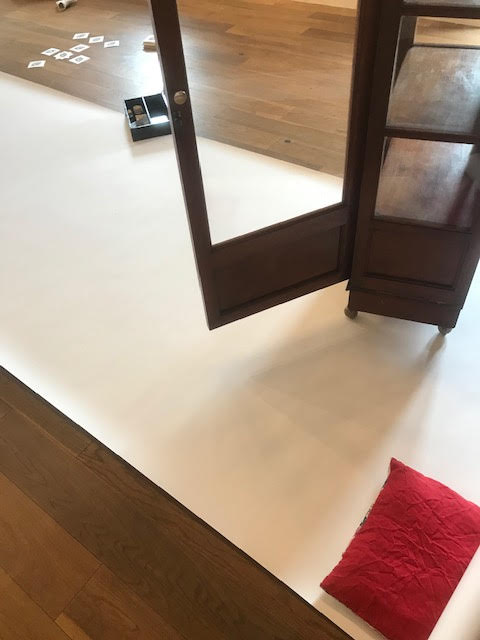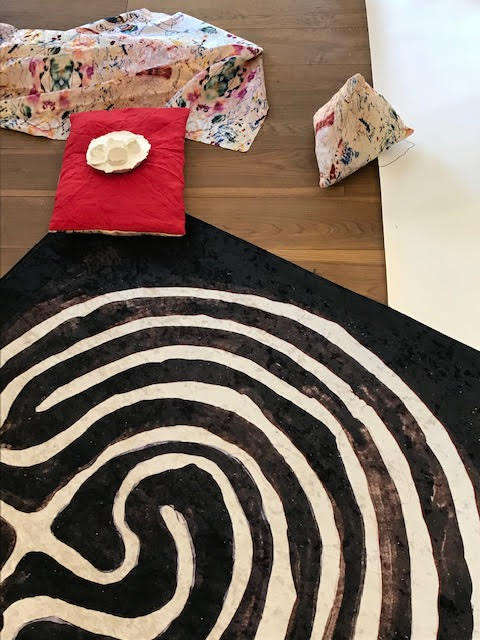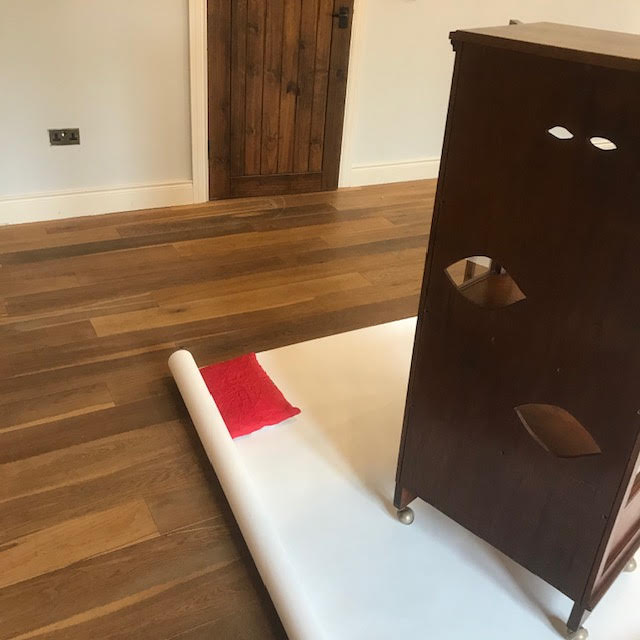
11 May Listoke – Drawing with objects in the space
I regard the things I make as tools, relational objects. The morning I arrive in Listoke I draw the objects into position. I am alone. It is just me and the objects. There is no plan yet, per say (beyond what I packed to bring here), I take the time to get into the headspace, position, play and allow them to inhabit space available. I consider the large roll of fabriano paper as a physical time line to work along. It will help evidence what happens in the next 24 hours. Making, crafting with the hands as an experiential thing. An embodied evidence of being with the material in dialogue. I write about what is happening.
I used the physical paper timeline to try and keep the liveliness in the work – how will meaning arrive in the work? My performances will attempt to explore the agency of the relational objects by negotiating those boundaries with my body and the systems I’ve designed. However I try to understand all these systems, some are elusive. Vulnerable and real. Maybe I’ll only know what happened after I see the photos?
“Curating, thinking on and in, looking with, being in and with, dialogue with objects, surfaces, installation, interaction with, relational space, objects anchor me, recording, performing, journaling. Participants are in the objects. Communicate the intended outcome now” (Extract from the notebook 5th May 12.54pm)
What is it about placement in the work – thinking on this more now as I am inside the formal space – placement is what I consider to be the drawing element acted out with the objects. It’s about balance/tension and composition within the cabinet or upon the paper timeline that can shift again when the object is moved on the table or used differently. Placement is a temporal anchor.
I feel obliged to have a list of activities/schedule written to be able to communicate to Colm* what it is I need his help with. Prior to being onsite I shared my exhibition proposal with him. I write a checklist in my notebook for the shots I imagine will work. Colm will record my performances with the objects along the physical time line. We will use moving and still images to record, We discuss and agree before we begin. Our dialogue becomes another interaction, a collaboration with shared agency to capture the potential moment of ‘intra-action’ Barad (2007) with me and the relational objects.
I am excited for the other things that may occur, still unknown to me. This is the bonus material – full of potential.
‘A careful negotiation takes place between the rules and systems that belong to things and those that I create. Whilst I seek to acquire an intimate understanding of matter, I enjoy the fact that it, nevertheless, eludes us. These points of resistance at the boundaries of possibility often lead to unanticipated lines of enquiry.‘ [Patel]
I think about being a conduit – artist as lynchpin/linchpin and that quality of attention, the focus that I bring to the ‘event’, happening/intra action. It is expressed by, through and with the hands. Yours/his/theirs/my hands.
Jan Verwoert, in Control I’m here describes it – “to be able to shape and make decisions on the medium of communication that defines both systems of curating and education. It also means that we would be able to find and define our own pace or communicating and working, be as responsive to social situations and conditions as we can while accepting that collaboration is a continuous learning process. As anyone involved in collaborative processes will confirm, collaboration is not easy and often does not fit into standardised means of production.”
Do my performances bring attention to the shifting uses of the relational objects? How does the work change, as I shift the context of each object – does it manifest in different forms in small quiet moments. Conflict and tension between intention/plan and surprise/chance – things I cannot measure yet, things I do not perceive. That captured on the still image/moving image is not the whole story.
References
Barad, K. M. (2007). Meeting the universe halfway: quantum physics and the entanglement of matter and meaning. 2nd Ed. USA Durham & London, Duke University Press [PDF]
* Colm Mullen
Colm is a childhood friend, we grew up together listening to the same music. We both work in a socially engaged capacity in the community. We have worked together before – the capes performance at the AAEX opening night.
https://colm-mullen.squarespace.com/
Jaimini Patel (website) [http://www.jaiminipatel.com/]









